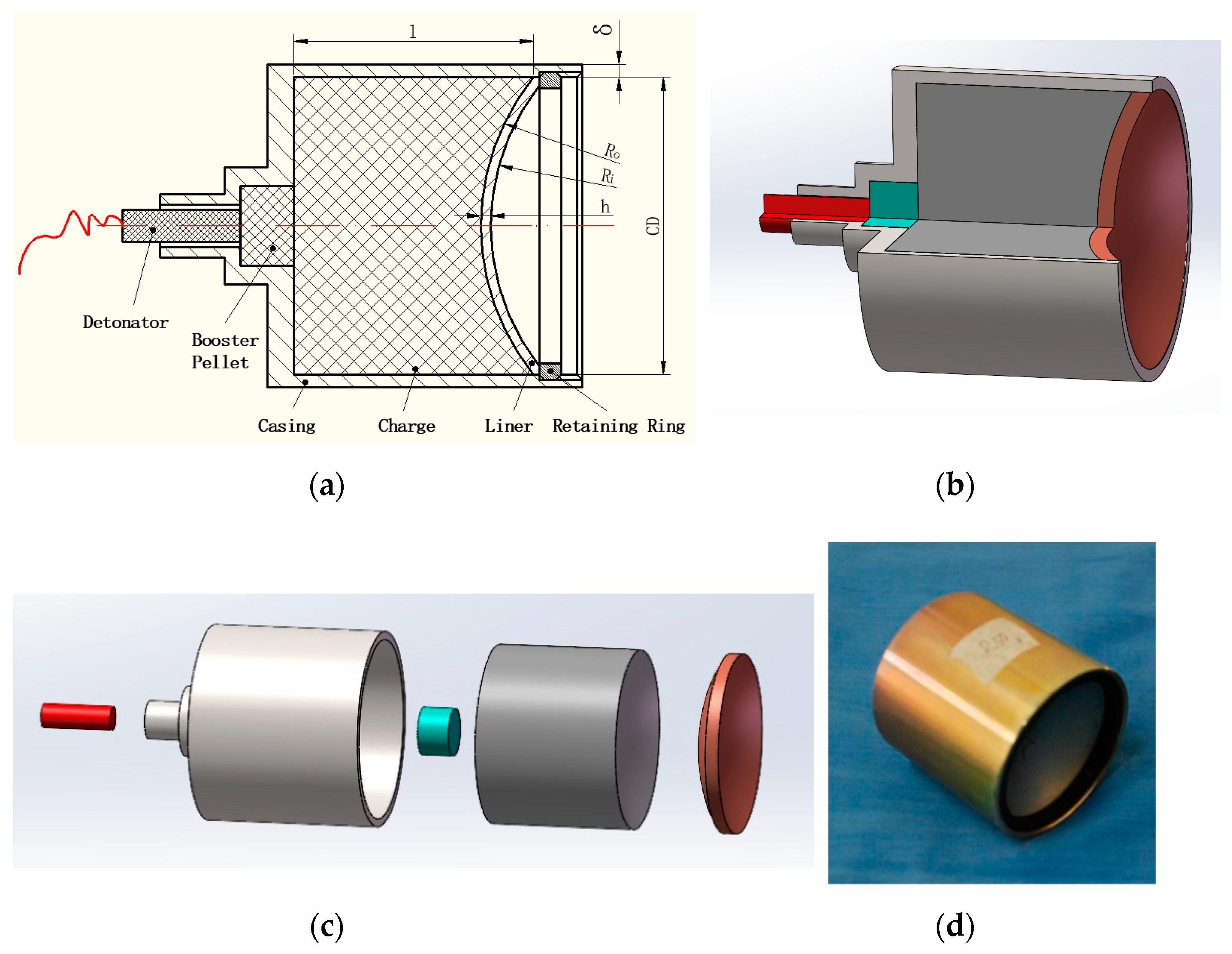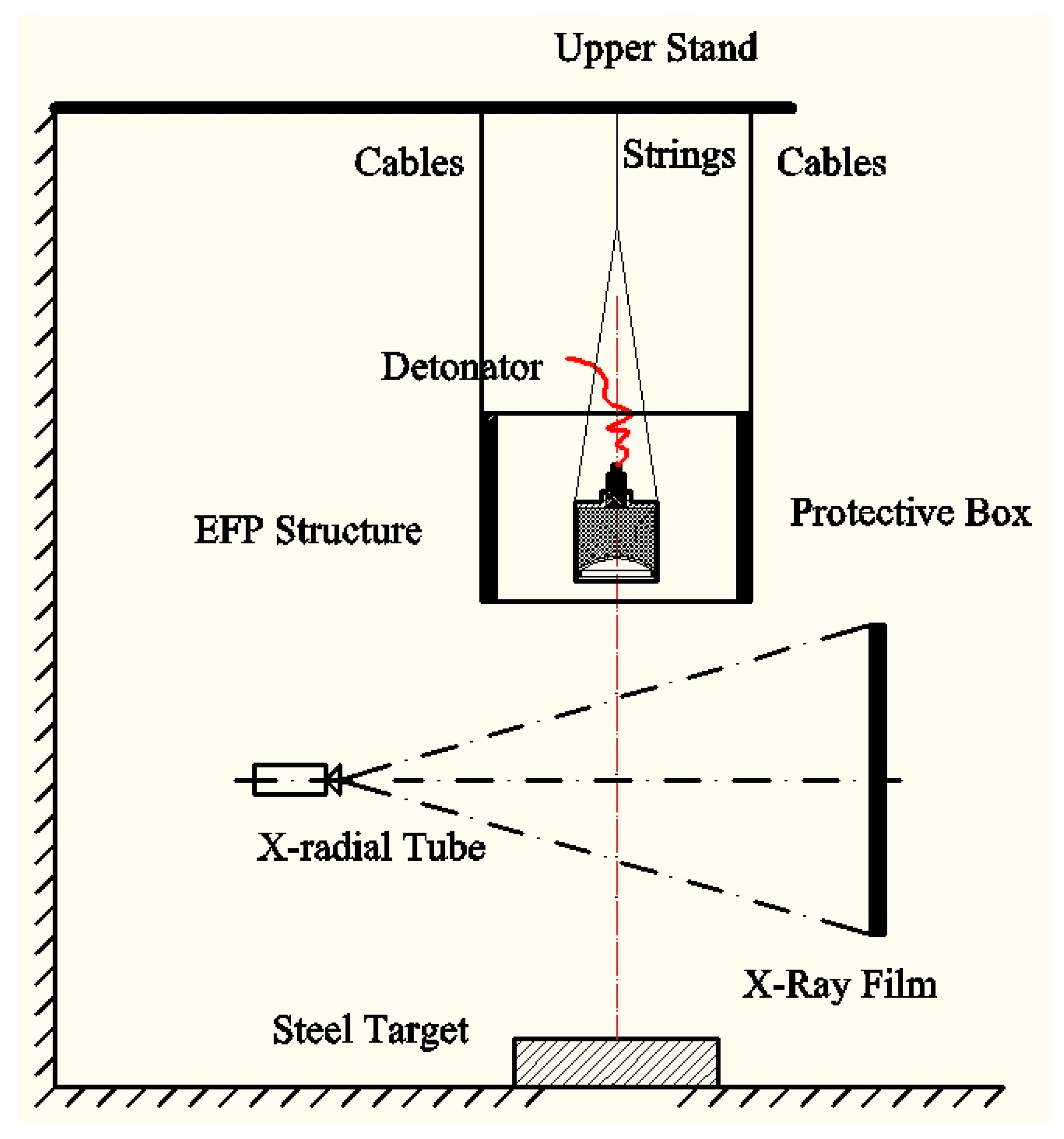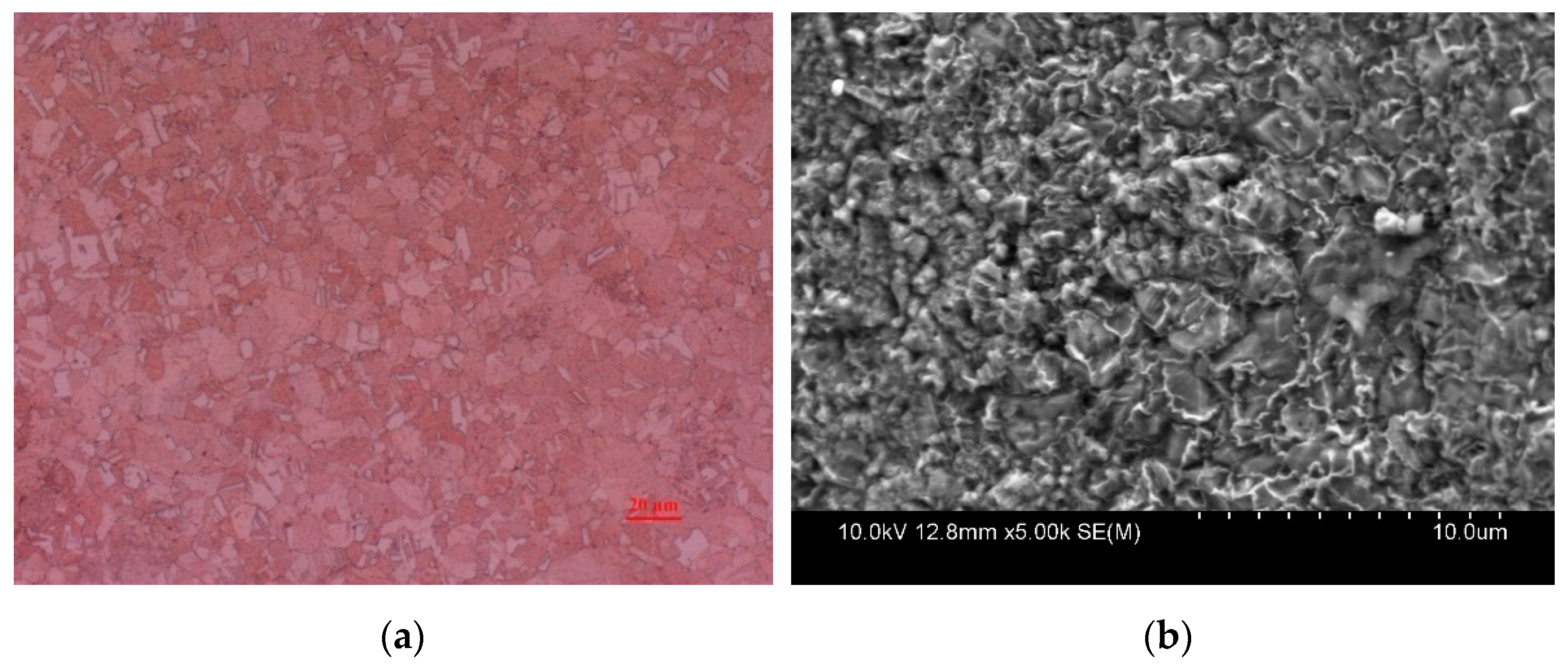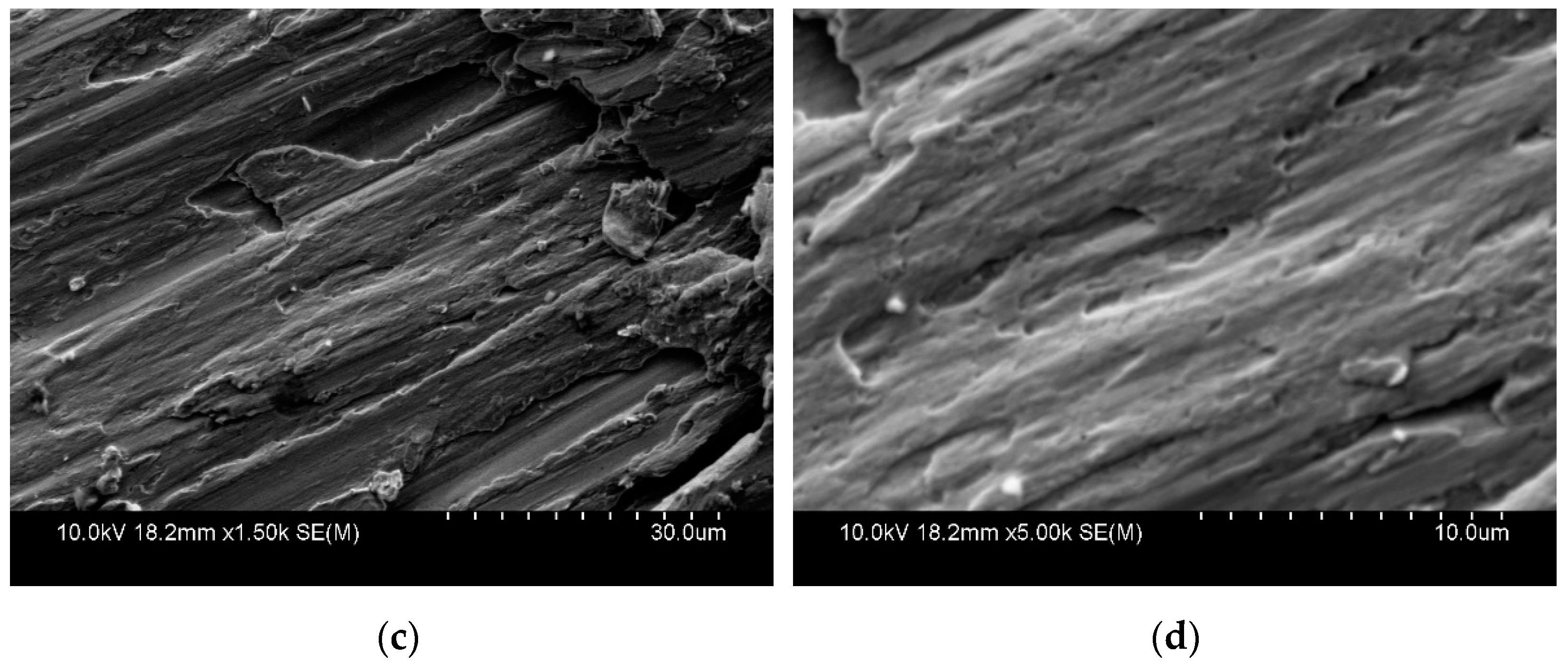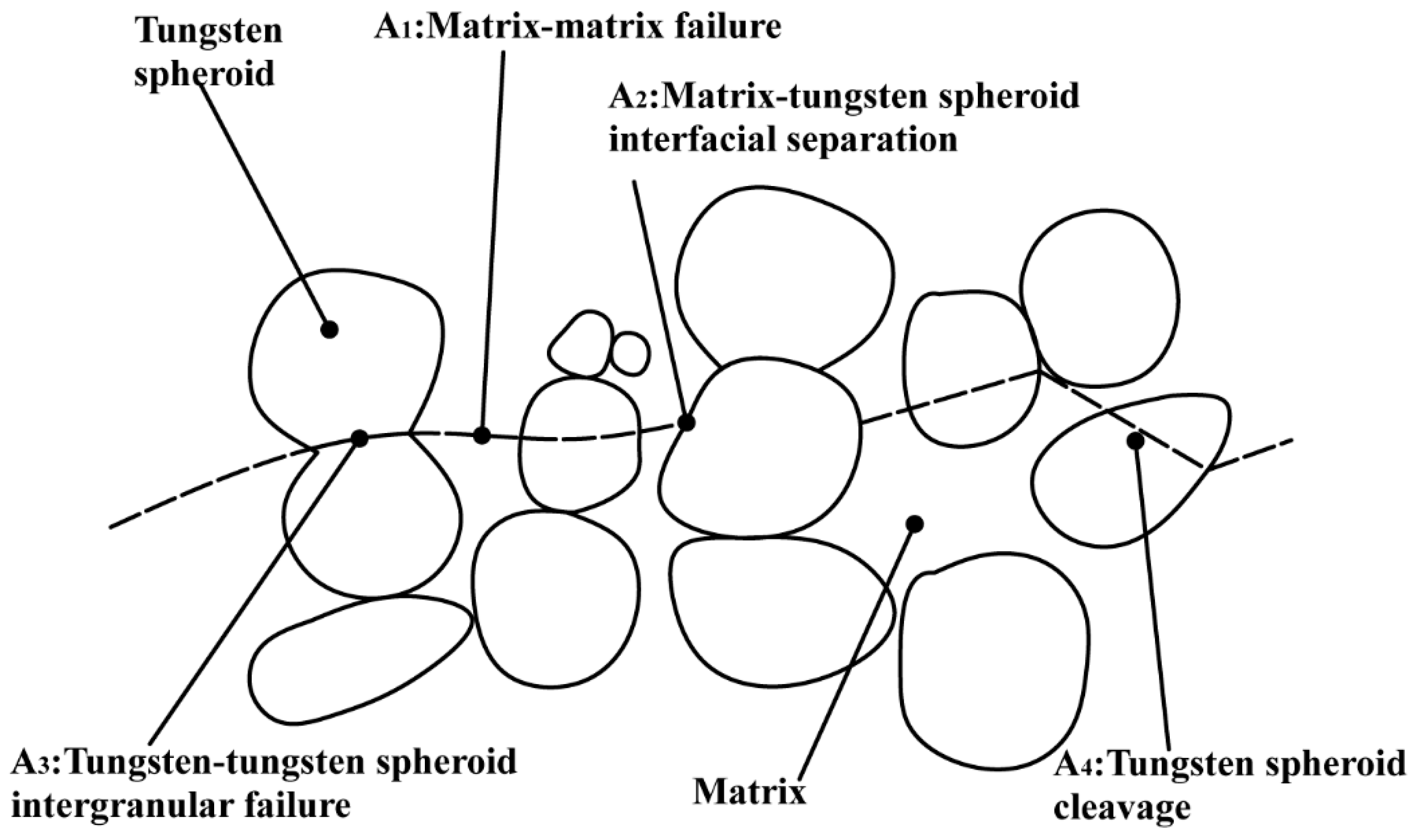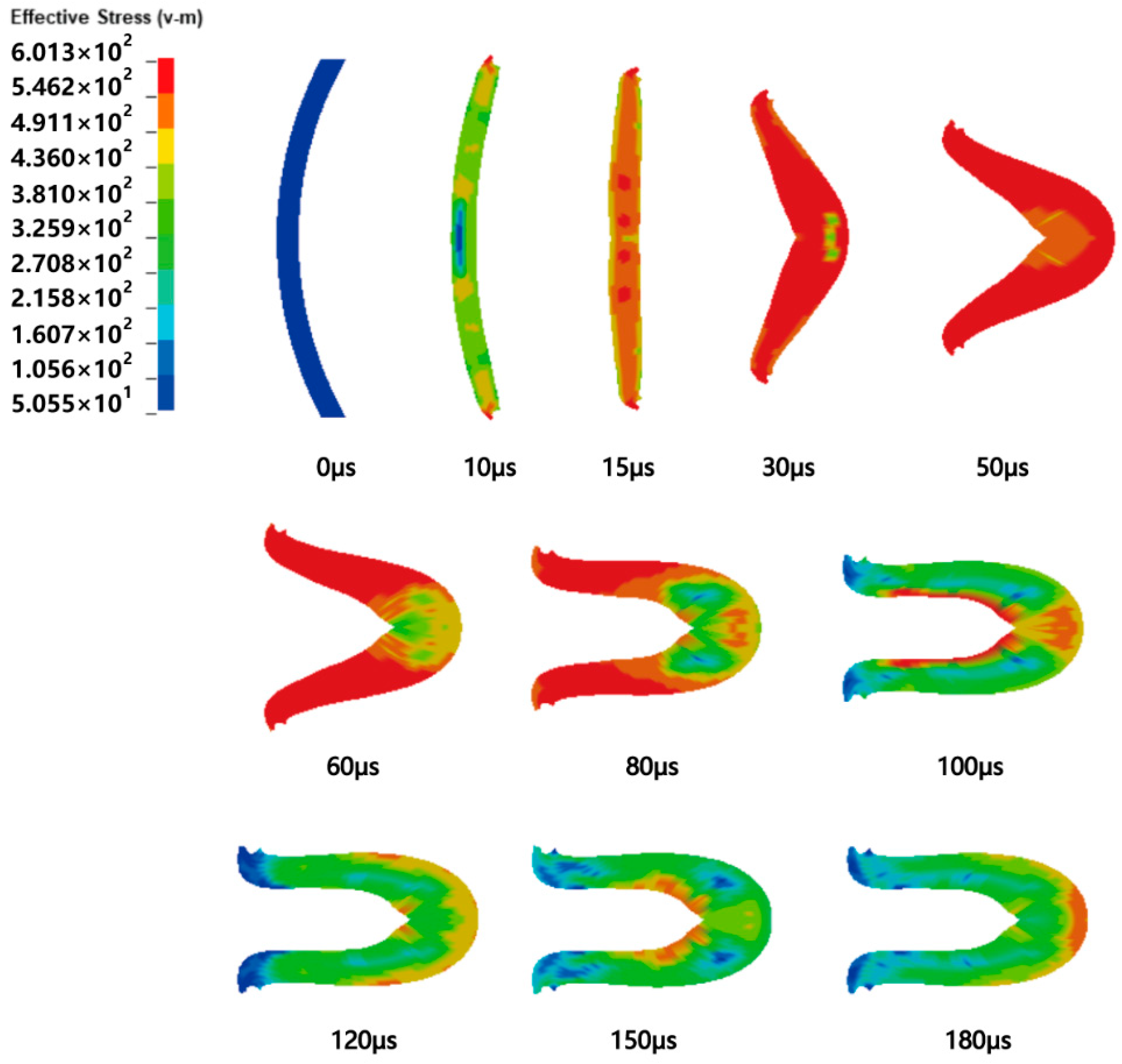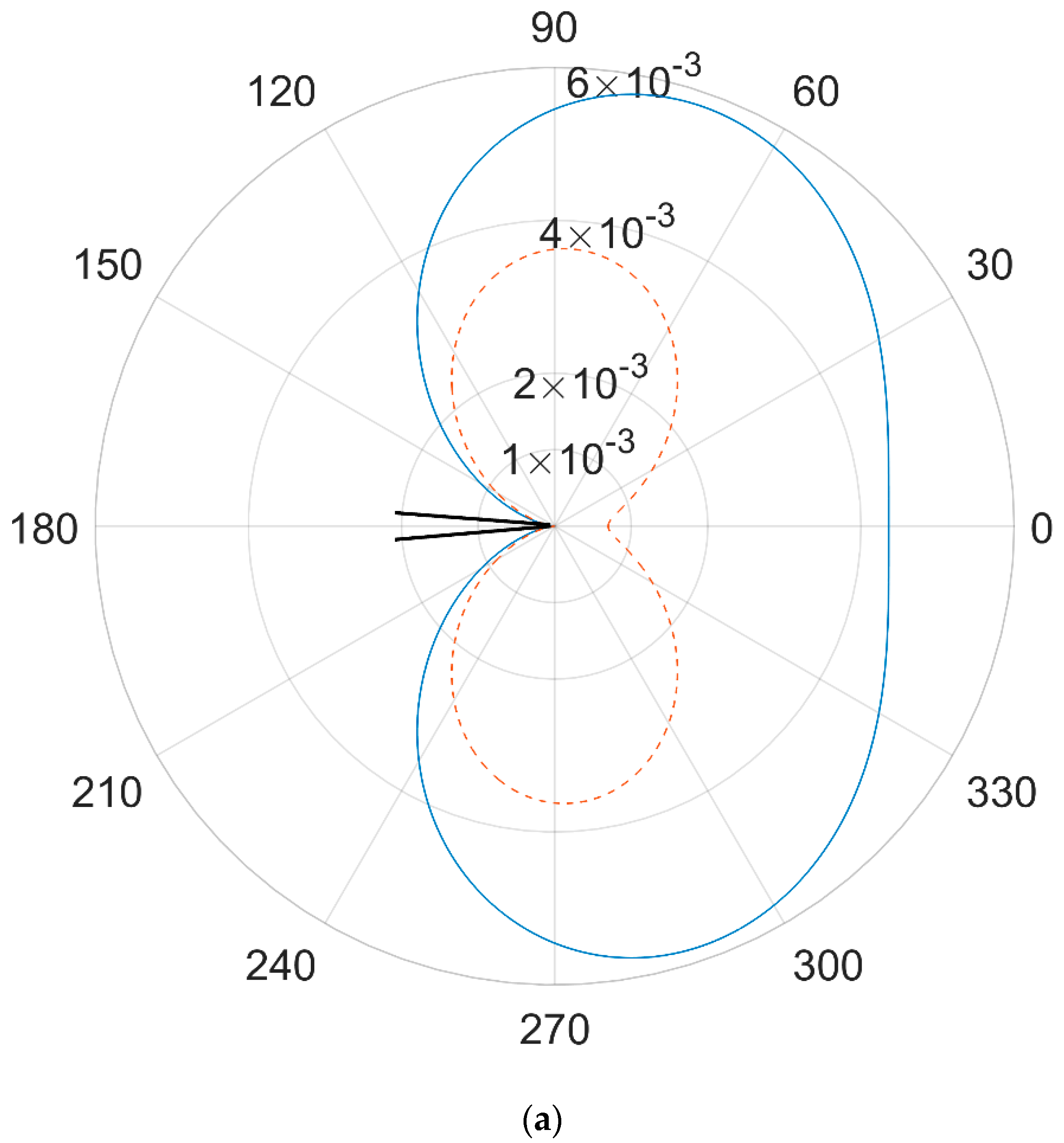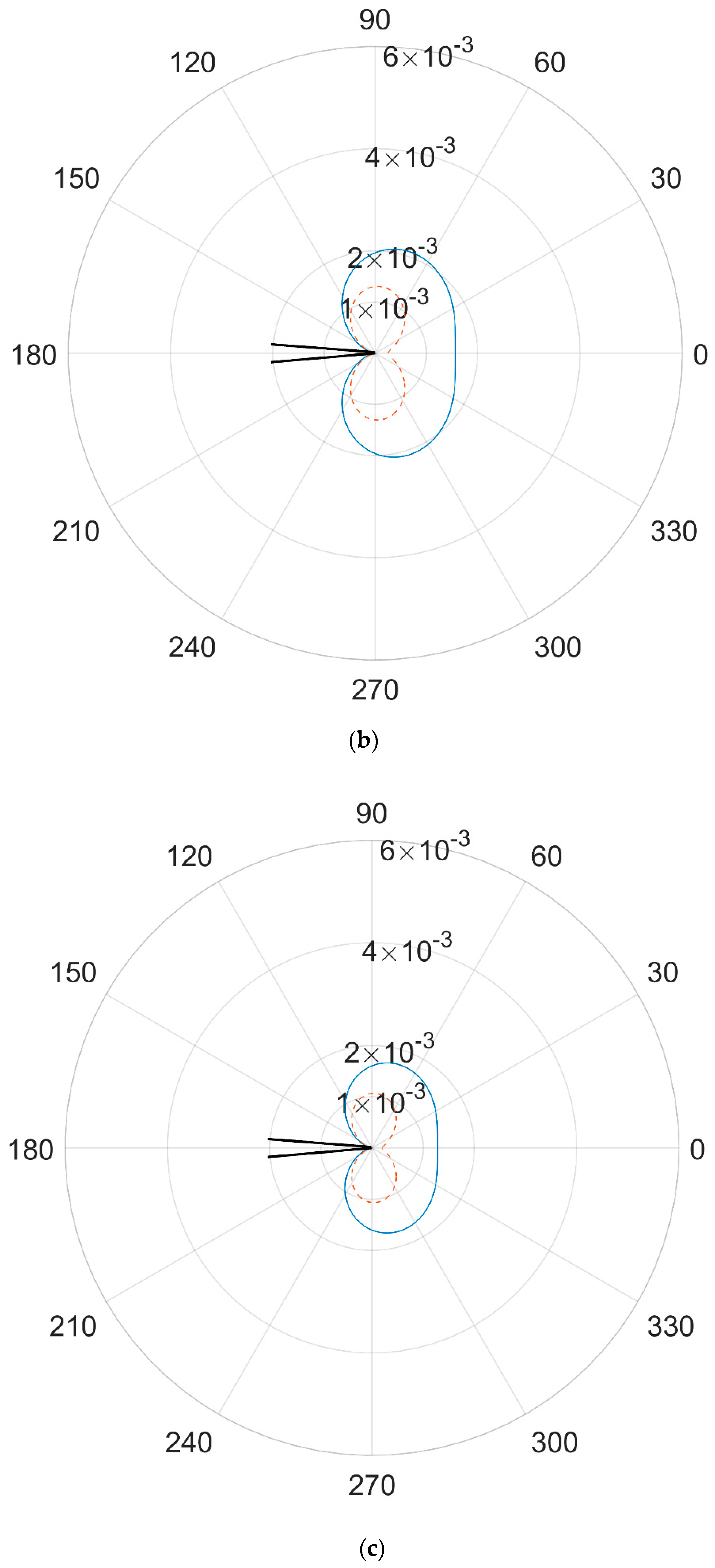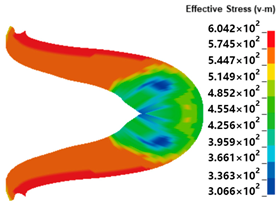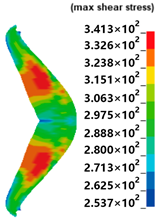Due to the well-formed performance under explosive loading, copper EFP’s forming characteristics are analyzed in the numerical simulation. Then, associated with the stress and strain conditions under explosive loading, the fracture phenomenon of tungsten heavy alloys can be analyzed in the fracture mechanism.
4.1. Numerical Model of Copper EFP
As shown in
Figure 8a, all of the components of the EFP charge structure are modelled with the 2D Lagrange algorithm in LS-DYNA. Central point initiation is deployed to initiate the explosive. The elements are axisymmetric solid-area weighted shell, with mesh size of about 0.5 mm per grid, and a half model symmetric of the y axis is carried out. The mesh is shown in the grid model of
Figure 8b.
The material models of charge, casing, and liner are listed in
Table 2. The behavior of the high-explosive charge is characterized by the Jones–Wilkins–Lee (JWL) equation of state and high-explosive-burn constitutive model, which are widely used to describe the pressure–volume relationship of the explosive. The JWL equation of state defines the pressure as [
24,
25]:
where
A,
B,
R1,
R2, and ω are constants to describe the relationship between the pressure and the relative volume of the charge. The EOS parameters of explosive 8701 are listed in
Table 3.
The selection of material model and setting of parameters of the liner are essential to predict the forming state of the copper EFP. In this paper, the Grüneisen equation of state is employed in conjunction with the Steinberg–Guinan constitutive model to simulate the forming of the copper EFP.
The Grüneisen EOS [
26] can be used to describe how the materials interact with the shock wave and is based on Hugoniot’s relation between the vs. and the
vp, as
vs =
c0 +
svp, where vs. is the shock wave velocity,
vp is the material particle velocity,
c0 is the wave speed, and
s is a material-related coefficient. The expression of equation of state of Grüneisen for compressed state is:
In the expanded state,
where
C is the intercept of velocity curve between shock wave and particle,
S1,
S2, and
S3 represent the slope of the
vs-
vp curve, γ
0 is the coefficient of Grüneisen, and
a is one-order correction of
γ0.
μ =
ρ/
ρ0 − 1 is a non-dimensional coefficient based on initial and instantaneous material densities. The parameters of equation of state are listed in
Table 4.
The Steinberg–Guinan model [
27] is available for modelling materials at very high strain rate (>10
5 s
−1). The yield strength is a function of temperature and pressure. In the Steinberg–Guinan constitutive relation, the shear modulus,
G, before the material melts, can be expressed as…
where
p is the pressure,
V is the relative volume, and
Ec is the cold compression energy:
and
Em is the melting energy:
which is in terms of the melting temperature
Tm(
x):
and the melting temperature at
ρ =
ρ0,
Tm0.
The yield stress
σy is given by:
when
Em exceeds
Ei, here
σ0′is given by:
where
σ0 is the initial yield stress and
γi is the initial plastic strain. If the work-hardened yield stress
σ0′ exceeds
σm,
σ0′ is set to
σm. After the melting point,
σy and
G are set to one half their initial value. the material parameters of the Steinberg–Guinan model for the copper liner are presented in
Table 5.
The steel casing adopts the Grüneisen EOS and Johnson–Cook constitutive model. The Johnson–Cook model [
28,
29] is a widely used constitutive model which incorporates the effect of strain rate dependent work hardening and thermal softening. The Johnson–Cook constitutive relation is given by:
where
ε is the plastic strain and the temperature factor is expressed as:
where
Tr is the room temperature, and
Tm is the melt temperature of the material.
σ0,
B,
n,
C, and
n are material-related parameters. The material parameters of steel #45 for casing are presented in
Table 6.
4.2. Numerical Results of Copper EFP
Figure 9 shows the shape and effective stress of the copper EFP at typical time in the forming stage. In the first 30 μs after the detonation of the charge, the detonation wave is transmitted to the top of the liner first. Thus, the top part of the liner accelerates and deforms in axial direction. As it interacts with the detonation wave, other parts of the liner deform and accelerate in sequence, with the bottom of the liner deforming last, which can be seen around 50 μs. At the same time, the liner is driven by the detonation wave to move forward along the axial direction. Then, due to the velocity gradient in the head and tail of the liner, the liner flips, and the inner surface of the liner will squeeze or even collide, which can be observed from 50 μs to 80 μs. The extrusion of the liner makes the inner wall of the liner close to the axis to form a rod-shaped projectile. After 80 μs, the shape of the EFP is basically stable.
As shown in
Table 7, the maximum von Mises stress can be as much as 604 MPa at 68 μs, and the maximum shear stress can reach 341 MPa. The maximum plastic strain reaches 2.71 after 100 μs. So, it can be concluded that in the forming stage of the copper EFP, the liner undergoes maximum shear stress and maximum effective stress in the early 70 μs, and the maximum plastic strain can be as much as 3.0.
Table 8 makes a comparison of numerical simulation and experiment results.
L and
D are the length and diameter of EFP, and
L/D is the length to diameter ration of EFP. By the comparison of length, diameter, and length to diameter ratio, the numerical simulation results agree well with the experiment results, which verify the accuracy of the numerical simulation.
In conclusion, a feasible EFP liner should sustain tremendous stress in the early stage of forming without breaking. The liner has to bear large plastic strain under explosive loading, and undergo severe plastic deformation in the forming. Associated with the maximum stress and strain conditions in forming of EFP under explosive loading, the fracture phenomenon of tungsten heavy alloys can be analyzed in the fracture mechanism.
4.3. Analysis of Fracture Mechanism
In fracture mechanics, there are three modes of loading relative to a crack, as shown in
Figure 10. Mode I is also called the opening mode, where the principal load is applied normally to the crack plane, which tends to open the crack. Mode II tends to slide one crack face with respect to the other. Mode III is called the tearing mode, which refers to out of plane shear [
30]. On the microscopic scale, according to the feature of the fracture surface, the cleavage pattern is mainly produced by the tensile stress and results in the brittle fracture by separation (cleavage) across well-defined habit crystallographic planes [
31]. As Mode I is the most dangerous loading pattern among the three modes, the stress field ahead of a crack tip in the opening mode is used to analyze the fracture mechanism of tungsten heavy alloys.
Figure 11 presents the definition of the coordinate axis ahead of a crack tip.
σij and
τij are the stress tensor.
r and
θ are the defined polar coordinate axis with the origin at the crack tip.
KI denotes the stress intensity factor, and
ν is Poisson’s ration. The stress fields ahead of a crack tip in an isotropic linear elastic material can be written in the form of (13) as an isotropic linear elastic material [
32,
33,
34].
According to the von Mises criterion, yielding occurs when
σe =
σYS, the uniaxial yield strength. For plane stress or plane strain conditions, the principal stresses can be computed from the two-dimensional Mohr’s relationship:
For plane stress
σ3 = 0, and
σ3 =
ν(
σ1 +
σ2) for plane strain. Then,
By substituting the equations into:
setting
σe =
σYS, and solving for
r as a function of
θ for plane stress:
And for the plane strain,
where set
ν = 0.3 for metal materials.
Fracture toughness
KIC and damage tolerance
dy of the three kinds of materials are listed in
Table 9. The fracture toughness of copper is much higher than 90W–Ni–Co and W–25Re. The maximum fracture toughness of copper can reach 100 MPam
1/2, while the maximum value of tungsten alloy can just reach 60 MPam
1/2. The values of
KIC for 90W–Ni–Co and W–25Re almost stay the same.
dy, diameter of the process-zone at a crack tip, which indicates the damage tolerance of the plastic zone, are listed in the
Table 9.
dy of the copper ranges from 1 mm to 1000 mm, while damage tolerance of 90W–9Ni–Co and W–25Re varies from 0.1 mm to 1 mm.
The lower values of fracture toughness and damage tolerance of 90W–9Ni–Co and W–25Re can be a convincing evidence to explain the fracture phenomenon in the flash X-ray experiment, but more detailed discussion should be given. By substituting the maximum values of stress and the fracture toughness of the three kinds of materials in Equation (17) and Equation (18), the crack-tip plastic zone shapes estimated from the elastic solutions and the von Mises yield criterion for Mode I of loading can be obtained, as shown in
Figure 12. The solid line is for the plane stress zone, while the dashed line is for the plane strain.
As presented in
Figure 12, the plain strain condition suppresses yielding, resulting in a smaller plastic zone when compared with the plain stress. The maximums of
r(
θ) for the three kinds of materials are listed in
Table 10. For the plane stress condition, the maximum
r(
θ) for plane stress can reach 58 mm for copper, while for the plane strain, the value could only reach 36 mm. For the tungsten alloy, the values of
r(
θ) are much lower than copper. The maximum
r(
θ) is about 17~21 mm, while for plane strain the values reduce to 1 mm. The maximum of
r(
θ) for the plane strain of tungsten alloys is consistent with the values of
dy, which indicates the damage tolerance of the plastic zone.
In conclusion, the crack-tip plastic zones of 90W–9Ni–Co and W–25Re are much smaller than copper. As the plain strain is the most dangerous condition in the fracture mode, it has more reference significance to understand the fracture mechanism of tungsten alloys. Under explosive loading with severe stress and strain conditions, cracks may occur inside the material. Then, due to the severe stress concentration at the tip of the cracks, it is easy for the cracks to propagate and trigger the cleavage in tungsten alloys. In
Figure 5 and
Figure 6, cracks and pores are easily observed, which are consistent with the prediction of the crack-tip plastic zone. While for copper with excellent ductility, it has the ability to bear a considerable amount of plastic deformation. In addition, it will not fracture even with cracks due to its big enough crack-tip plastic zone, as shown in
Figure 12a.
In addition, the material selection criteria of the EFP liner can be further enriched and specified based on the value of
r(
θ) for the plane stress. The material selection criteria of the EFP liner can be summarized as below: (i) the most potential candidate of material should have fracture toughness
KIC be of 70–150 MPam
1/2, diameter of the process zone
dy be of 10–1000 mm. (ii) Impact toughness
αk can be an alternative guideline, which should be in the range of 1500–2000 KJm
−2. (iii) Fracture surface appearance of microvoid coalescence both in the quasi-static and dynamic failure is preferred [
19]. (iv)
r(
θ) of the crack-tip plastic zone can also be an alternative guideline to explain the fracture phenomenon in explosive loading. The potential candidate of an EFP liner should have a crack-tip plastic zone
r(
θ) as much as 58 mm for plane stress, and reach 36 mm for the plane strain condition. Then, the material could have the ability to sustain tremendous plastic deformation in the forming under explosive loading and form an EFP like copper.
